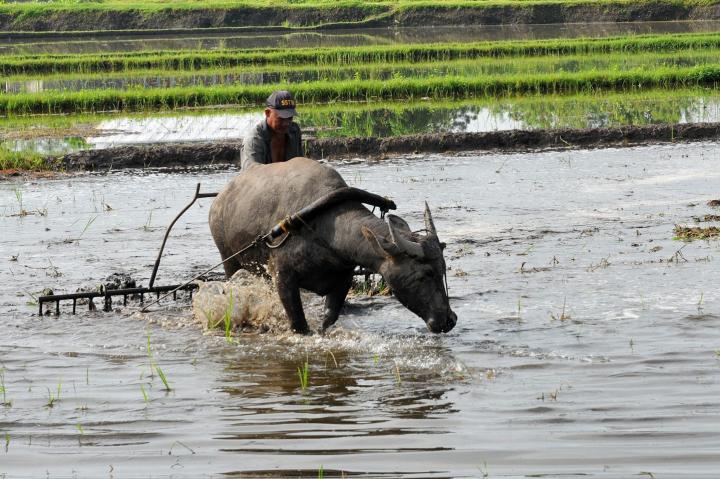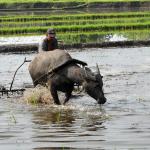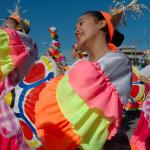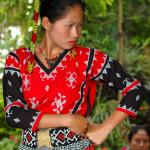Green & Graphic Getaways
Mindanao is truly a travel photographer's paradise with dozens of untapped eco tourist sites and unexploited destinations, where Mother Nature is at its best and is choosing to paint its sceneries with every possible colour, always changing with the seasons.
Long before the Philippine government endorsed eco-tourism as a policy, the exotic island of Mindanao was recognized as a favourite destination for green travellers. There are endless subjects to aim your lens at, impressive wildlife, dynamic landscapes, majestic waterfalls, multi-coloured rice fields, vivid ethnic festivals or the fascinating local indigenous and tribal cultures. The region offers many occasions to get closer to nature with incredible backdrops for Landscape, Nature and Wildlife photography, for both professional as well as amateur photographers, for die-hard nature lovers and for enthusiastic, adventurous people that are looking for an extraordinary outdoor experience. Mindanao provides many opportunities for the responsible and environmentally conscious travellers; bird watching is just one of the thrilling outdoor activities that can be enjoyed in this tropical paradise. The equatorial climate of Mindanao allows bird watching to be a year-round activity. There are various accessible habitats that are home to numerous kinds of woodpeckers, hornbills, parrots and the great Philippine Eagle, one of the largest and most powerful eagles on earth and, at the same time one of the world's rarest and critically endangered birds. The lush forest in Lake Sebu is one of the existing areas where sightings of this monkey eating eagle havebeen recorded. Confirmed sightings of the raptor were also reported in South Cotabato and in the boundaries of Sarangani and Maitum.
Lake Sebu is a picturesque lake on the flank of the Daguma Range in the south-western part of the land-locked province of South Cotabato, the area is known for its unique faunal and floral biodiversity. The surrounding rainforest is the territory of the Philippine cockatoo, swallows, kingfishers, herons, kites and other migratory birds. These rugged hills are holding trails that go high up in to the moss-grown forests, several endemic species like the Spotted Imperial-Pigeon, the White-eared Tailorbird, the Grey-hooded Sunbird and many more. Rare species of butterflies, white deer and the red monkey are sighted near the adjacent Lake Holon and on the slopes of Mt. Melibinogy. Wildlife photography can be very tricky and requires a lot of effort, patience and time, it is also one of the most demanding aspects of nature photography, wild birds and animals never stay in one place for long and are often difficult to approach, but these challenges make the rewards that much greater. Photographing the wildlife in the Lake Sebu area is also exciting, here you can experience the thrill of encountering beautiful animals in their natural habitat and the chance to capture that perfect moment.
The highlands of Lake Sebu are home to the T'boli tribe, an indigenous tribe that is well known for their spirit infused and dream-inspired T'nalak weavings, The T'nalak is considered as a sacred cloth and made from back loomed abaca fibres. The tribe's culture is inspired by its natural environment and very much connected with nature, their high regards with the spirits of nature is evident in their simple way of living and their craftsmanship. The members of the T'boli distinguish their selves, from other tribes by their brass ornaments rings, bracelets, earrings and colourful tribal attire with magnificent embroidery. Being able to visualize the essence of the tribe's unique culture and rich tradition in their ancestral domain is a great moment not to be missed for any photographer. The T'boli people love to smile and are genuinely interested in foreign visitors, but respect people's privacy and make sure you ask permission before taking photographs of tribal members and their cultural and religious places.
There's no better way to see the best of what scenic Lake Sebu has to offer than stepping aboard a breath-taking boat tour, the floating Fishermen's dwellings on the lake and along the coastline of the many small islands, the man-made tilapia fish pens, the T'boli tribe members in their native, wooden canoes and the exquisite drifting lotus flowers provide a non-stop photo happening. The spectacular scenery of the majestic, rumbling and tumbling Seven Falls, a series of river plunge along the mountain forests, creates a powerful, awe inspiring spectacle. Because of the altitude of the waterfalls, almost 300m (984ft). the local climate is most of the time overcast, creating perfect light that brings out the beauty in the image. Keep in mind that these falls can drop huge amounts of water, which produces a mist that can drive moisture straight at the lens of your camera. Thrill seekers can glide down from a zip line that is providing an exhilarating panorama of the verdant canopy and the winding white river system. To get the most of this stunning adventure, secure your camera tight to your body and adjust its setting properly for high speed images. Once you have made the ride down it is not difficult to imagine why this place is often called Mindanao's hidden gem and a photographer's delight. When you are photographing a landscape in Mindanao, you are composing a work of art, a wide sweeping brushstroke that captures the grandeur and mystery of a place for a marvelous image that is worth framing.
Going downhill through the mountain roads, heading for the small town of Banga you will pass by magnificent views over the rice paddies and the corn fields in the lowlands of the Allah valley and Koronadal valley, spectators are awarded with another eye-catching mosaic of nature's beauty. In the wet season the farmlands are in preparation for ploughing and resemble a mirror reflecting the sunshine, creating sparkling colours that come alive in the water. When the rice plants begin to grow to maturity the croplands turn in to various tincture of luscious green, after a while, in the dry season, when the rice is ready to be harvested; the fields are covered with gold and yellow. One of the defining characteristics of the Mindanao landscape is the carabao, a multi tasked, environment friendly animal and the most cherished property of any rice farmer. The sight of a plodding carabao hauling a plough through the wet and heavy mud, loosening the soil in preparation for sowing the fields and the local men and, women working in the rice paddies, wearing their traditional broad-brimmed sunhat for protection from the blistering sun is worthwhile to be documented with your camera.
Mt. Matutum, an isolated, non-active, volcano, is located within driving distance of Lake Sebu; its steep slopes are home to various species of orchid's fern and lichens. The montane forest is inhabited by varied species of tropical birds, like the Negros Fruit Dove and the bleeding heart pigeon. Mt. Matutum is also the natural terrain of the musang or wild civet cat, locally known as Alamid. Another photogenic creature that is roaming the hillsides is the Philippine tarsier, one of the smallest known primates in the world. These nocturnal animals can be seen at day time at the tarsier sanctuary in the small Blaan village in barangay Linan, located at the foot of the mountain. The Blaan is an indigenous tribe that is still upholding their own traditional culture and ways of living. Photographing tribal people in their every-day environment is a fantastic way to show more about a person than just the first impression. Remember that smiling is always a great way to break the ice and that you are a guest of the local Blaan tribe; therefore always act respectful and courteous. The strong facial features of the elder tribesman and women are stamped by life, the elements of nature and time; they are weather beaten and irrepressible looking. Their proud expression reflects the formidable durability of the narra tree and the resiliency of bamboo. The natural, always curious and smiling faces of the youngsters of the tribe will encourage you to capture their intense and youthful appearance in striking images.
Colour is a primary feature of the Philippines, whether it is the costumes of the indigenous people or the multitude of traditional festivals that are celebrated all year round. Each festivity is captivating and unique in its own right and worth taking the time to experience. They are special days of great joy and happiness and an important event for all people to extend their friendship and hospitality to one another. The many fiestas held in Mindanao offer a completely different view of the people and the region they live in, portraying the culture and folklore better than anything else. The large crowds and vibrant colors make these exciting commemorations a great topic for travel photography. Parades and festivals can be very difficult to photograph because of moving performers or participants, large crowds of spectators and, sometimes, limited access. So, try to be there before the festival starts and get a good position. This allows you to take good pictures while the parade moves past you.
It does not matter if you like landscape, wildlife, nature or people and portrait photography, the island of Mindanao opens up a wide scope of genres for the fervent photographer to explore, providing plentiful photo opportunities that will go beyond your own and others expectations. An excellent possibility for the wannabe professionals to improve their photographic skills and an ideal setting for the more experienced photographer to create that award-winning shot. There is no limit to the amazing places and interesting faces that can be
captured in a digital frame during your stay, once back home your pictures will form a timeless reminder of your Mindanao adventure. It will be an unforgettable experience that should be shared with others, remember to show respect for nature and help to protect the environment for future generations, as the old proverb goes; "Take nothing but pictures, leave nothing but footprints".
Travel photography is a lot more than just taking pictures; it can catch the eye of a wide audience, illustrating the importance of preserving the magnificent nature and the different cultures in Mindanao.
 ThingsAsian
ThingsAsian



















